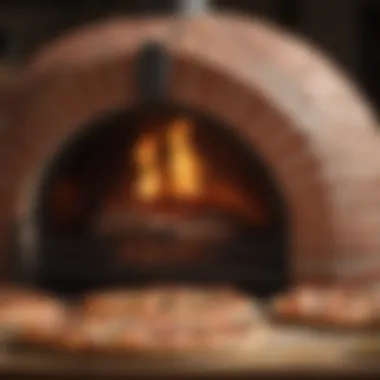Choosing the Best Wood for Brick Oven Pizza


Intro
When it comes to crafting the perfect brick oven pizza, selecting the right wood is like picking the right paint for a masterpiece. The type of wood you use not only impacts the flavor but can also significantly influence the cooking process and the overall experience. This delves into the types of wood that can elevate your pizza-making game, looking closely at how each kind affects heat retention and flavor infusion.
Choosing the wood isn't a small detail. It’s an art, and understanding the various aspects can mean the difference between okay pizza and something that dances on your taste buds, inviting you back for another bite. Whether you are a pizza lover at heart or just someone keen on mastering the craft, this will guide you through the ins and outs of wood selection.
Imagine the smell of wood smoke curling through the air, mingling with the aroma of fresh dough and toppings. This article goes beyond the science of wood and dives into the very essence of why it matters. Shall we dive a little deeper?
Preamble to Brick Oven Pizza and Wood Selection
Choosing the ideal wood for brick oven pizza goes beyond mere preference; it’s about embracing a tradition that intertwines flavor and technique in a purposeful way. The choice of wood brings not just heat but also character to the pizza, influencing the overall taste experience. This discerning selection is crucial, as the wood interacts with both the oven's heat dynamics and the ingredients used in the pizza.
Our deep dive will unravel the intricacies of selecting wood, as improper choices can result in disappointing outcomes—both in flavor and in cooking efficiency. Pizza lovers know well that it’s in the details where perfection resides. A well-informed choice of wood contributes to achieving that coveted crust with the right balance of crispness and chew, while also offering subtle layers of flavor that can lift a simple Margherita to new heights.
The Artistry Behind Brick Oven Pizza
The craft of making brick oven pizza is likened to fine art, where the oven itself serves as the canvas. The flames fueled by the wood choice play an indispensable role in this artistry. Each type of wood brings its own idiosyncrasies—from burn duration to smoke characteristics, all of which lend themselves to the overall pizza production process.
For example, oak is cherished in many circles for its steady heat output and subtle flavor infusion, while hickory might impart a robust smokiness that can take a classic pepperoni to a whole new dimension. Thus, understanding how different woods contribute to the cooking experience transforms the act into a true culinary journey.
The Central Role of Wood in Cooking
Wood serves as the heart of the brick oven, establishing the primary source of heat. The manner in which wood burns, how efficiently it retains that heat, and how it interacts with the pizza all contribute to the final result.
When seasoned properly, wood generates a consistent temperature, crucial for baking those pizzas to perfection. The interplay between the wood's heat and the dough’s moisture creates the magical transformation that occurs within those few minutes of cooking. Without the right wood, the bottom can turn black while the cheese remains uncooked—a common pitfall for those unfamiliar with the nuances of wood selection.
As we navigate through the specifics of wood selection, we will also touch on aspects such as moisture content, the inherent flavors of various woods, and how each can change the game in the world of pizza making.
"Selecting the right wood can mean the difference between pizza perfection and a charred disaster."
Understanding these foundational elements is paramount not just for enthusiasts aiming for culinary accolades but for anyone wishing to venture into the art of pizza making in a brick oven.
From here, we will explore the characteristics that define the ideal wood types to enhance your brick oven experience.
Characteristics of Ideal Wood Types
Selecting the right wood is paramount in crafting the perfect brick oven pizza. The type of wood influences not only the cooking process but also the flavor profile of the final product. This section explores the key characteristics that make specific woods suitable for pizza-making. Understanding these traits can guide enthusiasts in their journey to wood-fired pizza perfection.
Heat Output and Retention
Not all wood burns the same. Some woods generate high heat quickly, while others offer a steady, long-lasting burn. The heat output directly affects the cooking time and quality of the pizza crust. For instance, hardwoods like oak and hickory are known for their excellent heat retention and output, allowing the oven to reach and maintain high temperatures efficiently.
A well-heated oven can emulate the conditions found in prestigious pizzerias, where the magic of wood-fired cooking shines. Conversely, softer woods like pine may ignite easily but tend to burn out swiftly, leading to unpredictable cooking conditions. This inconsistency can ruin the delicate balance of a good pie, leaving you with either a charred crust or an undercooked center. Choosing the right wood type ensures a perfect balance.
Moisture Content and Seasoning
Moisture content plays a significant role in how wood burns and what flavor it imparts to food. Freshly cut wood, or green wood, tends to contain a high level of moisture. This excess water can lead to excessive smoke and a frustrating cooking experience. Seasoned wood, on the other hand, has been properly dried, typically over six months or more. This ensures that it burns cleanly and efficiently while allowing for optimal heat output.


If you want to achieve that perfect crust, you must prioritize seasoned wood. The way wood is cut also affects how well it seasons. Split wood, for example, dries out faster and burns better compared to whole logs. Hence, understanding how to season and store wood is vital for achieving great results.
Flavor Contributions to Pizza
Wood isn’t just fuel; it’s a flavor enhancer. Different types of wood impart distinct tastes to the pizza, contributing to the overall experience of a meal. For example, oak provides a robust flavor that's often associated with classic barbecue, while fruit trees like apple or cherry lend a subtler, sweeter essence to the pie. The choice of wood can transform an ordinary pizza into an unforgettable dish.
There’s an art to pairing wood with toppings, too. For instance, if you’re using spicy sausage or tangy tomato sauce, a milder wood like maple can complement it beautifully. Conversely, stronger-flavored toppings may benefit from the bold char of hickory. Therefore, understanding the nuances of how various woods contribute to flavor can elevate your cooking game.
"Choose your wood wisely; it’s the heart of your pie's personality."
In summation, the characteristics of ideal wood types encompass not just the heat they produce or the moisture they retain but also the rich flavors they deliver. Selecting the right wood ensures that you’ll achieve the crust and taste that resonate with authentic brick oven pizza. This understanding of the fundamentals prepares pizza lovers and culinary explorers alike to make informed choices in their pizza-making adventures.
Common Types of Wood Used for Brick Ovens
Choosing the right kind of wood for a brick oven isn't just a footnote in the culinary playbook; it forms the backbone of the cooking experience and the resulting flavor profile of the pizza. Each type of wood brings its own unique characteristics to the table, affecting not just the heat but also the aroma and taste of the food being prepared. In this section, we’ll explore several common types of wood that are particularly favored in the world of brick oven pizza cooking.
Oak: A Classic Choice
Oak stands tall as a traditional favorite for many pizza enthusiasts. Its steady heat output means that it can maintain high temperatures for extended periods, making it a reliable option for those long cooking sessions that are essential for perfecting that crispy crust. Cooks often appreciate how oak produces a slow, even burn, which helps in achieving consistent results. Another significant advantage is that it is widely available and relatively affordable. Whether you're roasting meats or baking pizzas, oak tends to enhance flavors without overshadowing the ingredients themselves.
Hickory: A Bold Flavor Experience
If you’re looking for something that packs a punch, hickory might be your go-to wood. This type is known for its strong, bold flavor, which can intricately infuse pizzas with a smoky richness. It’s particularly delightful if you are preparing meat-based pizzas or if you simply relish a stronger flavor in your crust. However, a little goes a long way as using too much can overpower subtler ingredients. So, balance is key when you’re firing up that hickory wood.
Maple: Smoother Taste Profiles
Maple isn’t the first wood that comes to most people’s minds, yet it offers a unique approach to flavor enhancement. It brings about a mild sweetness that can complement your pizza's toppings beautifully. While it doesn’t provide the same level of smokiness as either hickory or oak, it's ideal for those who prefer a nuanced flavor where the toppings shine. Maple burns at a moderate temperature, making it suitable for a variety of styles and cooking techniques.
Fruit Woods: Apple and Cherry Variants
Fruit woods, specifically apple and cherry, add a delightful twist to the cooking process. Apple wood is renowned for imparting a subtly sweet and fruity flavor, perfect for lighter pizzas. Cherry, on the other hand, offers a slightly richer flavor, giving a warm and inviting aroma that can make the experience feel celebratory. Fruit woods are generally lower in density, which leads to quicker burning. Hence, they’re often combined with denser woods to balance out heat and flavor.
Mesquite: A Strong Smoky Impact
For those who crave intense flavor, mesquite is an exhilarating choice. Its high heat output and distinct smokiness create a memorable culinary experience, especially for those hearty recipes that thrive on strong flavors. This wood burns quickly, delivering an unapologetic smokiness that might be too intense for some. Therefore, mesquite often finds its way into mixed wood recipes, providing that kick when needed while other woods round out the taste.
"The choice of wood can amplify flavors, alter cooking temperatures, and completely transform your pizza experience. Make your selections wisely."
In summary, the types of wood used for brick ovens are not mere afterthoughts; they shape the overall character of the pizza. Each wood variety has its own set of nuances and advantages, and understanding these differences can lead to remarkable culinary creations. With the right choice, cooking pizza becomes not just an act of feeding but an artistic expression.
Factors Influencing Wood Selection for Different Styles of Pizza
When it comes to brick oven pizza, the wood you select plays a pivotal role in achieving the perfect slice. Different styles of pizza not only require varied techniques in preparation but also have distinct flavor profiles that can be significantly altered by the choice of wood. Understanding how the type of wood influences the cooking process can enhance the final product, making your pizza not just good, but exceptional.
In this section, we’ll explore how various characteristic factors like heat output, flavor infusion, and regional preferences steer the wood selection for popular pizza styles. Special attention will be given to three renowned styles: Neapolitan, New York, and Sicilian, each embodying unique traditions and tastes.
Neapolitan Pizza: Traditional Preferences
In the world of pizza, Neapolitan is often regarded as the gold standard. This style originated in Naples, Italy, and its authenticity is closely tied to its simple ingredients and traditional cooking methods. The wood choice here centers heavily on achieving a high temperature rapidly, typically ranging from 800°F to 900°F.


Wood: For a classic Neapolitan pizza, beechwood stands out as a favorite. Its ability to burn clean while generating substantial heat makes the cooking time notably quick, which is essential for that characteristic puffy crust. Furthermore, oak is a common runner-up, providing a mild smokiness without overshadowing the delicate flavors of the pizza.
Here are some key aspects to consider:
- Quick heat: Neapolitan pizza cooks in about 60-90 seconds, so the wood must generate high temperature efficiently.
- Flavor balance: The chosen wood should enhance the fresh, vibrant toppings without overpowering them.
- Tradition: Sticking to traditional wood types reinforces the authenticity that enthusiasts aspire to achieve.
"The wood you choose for Neapolitan pizza can be as integral as the dough itself; both work in harmony to create an unforgettable experience."
New York Style Pizza: Versatile Wood Choices
New York style pizza has carved out its own identity, often highlighted by its wider, sturdier slices and bold cheese toppings. Due to the vast array of flavors in New York, the wood selection tends to be more versatile, allowing for a range of taste experimentation. This style often gets cooked on a lower heat compared to its Neapolitan counterpart, usually around 550°F to 650°F.
Wood: Here, a mix of oak and maple wood becomes popular. Oak continues to deliver a steady, sustained heat while imparting a subtle flavor. Maple, on the other hand, can complement the enhanced sweetness of toppings like tomatoes and even certain cheeses.
Some considerations for New York style are:
- Sustained heat: Ability to maintain temperature over time without excess smoke, crucial for longer cooking durations.
- Flavor harmony: The wood should not dominate the dish; rather, it should create a balanced depth while enhancing the core elements of the pizza.
- Flexibility: The choice of wood permits combinations; mixing types can lead to new and exciting flavors with a bit of artistry.
Sicilian Pizza: Regional Influences
Sicilian pizza, with its thicker crust, is a hearty competitor in the pizza arena. It famously boasts a rich crust, typically considered a rectangular sheet style, and often features robust toppings. The style can handle the flavorful traits imparted by wood more than the other types mentioned.
Wood: Hickory is a hallmark choice for Sicilian pizza, known for its pronounced smoky flavor. This type pairs excellently with the heft of cheese and toppings usually found on Sicilian pizzas. Fruitwoods, such as cherry and apple, also see popularity due to their interestingly light sweetness, which contrasts pleasingly with the savory ingredients.
When selecting wood for Sicilian pizza, take note:
- Flavor robustness: Rich flavors can come through boldly from the wood, enriching the overall taste experience.
- Heat versatility: Hickory allows for high enough heat to create the well-cooked crust while infusing it with smokiness.
- Regional pairing: Stronger woods typically reflect the hearty nature of Sicilian traditional cooking practices.
By understanding how each pizza style benefits from specific woods, you position yourself to elevate your homemade creations. Each choice goes beyond the technical, weaving into the narrative of tradition, place, and personal flavor preference.
Environmental Considerations When Choosing Wood
Choosing the right wood for your brick oven pizza is not just a culinary decision; it carries significant environmental implications. As pizza lovers and cooking enthusiasts, it’s essential to navigate this aspect thoughtfully. Being mindful of wood selection can lead to a more sustainable lifestyle, positively impacting our planet while enhancing the flavor and quality of our pizza. Let’s dive into why this consideration matters, highlighting specific elements that can guide choices regarding the use of wood in cooking.
Sustainability of Wood Sources
Sustainability should be at the forefront of any wood selection process. When you opt for wood that is harvested with care, you are making a choice that supports responsible forestry practices. This means that for every tree taken down, another one is planted, resulting in a healthy forest ecosystem. Moreover, sustainable harvesting helps maintain biodiversity, which is an essential component for a balanced environment.
Several certifications indicate sustainable practices, such as the FSC (Forest Stewardship Council). Always check if your wood source holds such certifications because they ensure that wood comes from responsibly managed forests that provide environmental, social, and economic benefits.
Impact of Deforestation
Deforestation is a pressing global issue, and it’s not just a remote concern for forest-dwelling species. It affects weather patterns, carbon storage, and ecological balance. When we turn a blind eye to the origins of our wood, we might inadvertently support practices that contribute to deforestation, which in turn exacerbates climate change.
The downside of deforestation stretches beyond mere tree loss. It can lead to soil erosion and the loss of habitat for countless wildlife species. In choosing wood, keeping these impacts in mind ensures that the love for pizza doesn’t come at the expense of our planet.
Locally Sourced Options


When possible, sourcing wood locally has numerous benefits. First off, it reduces the carbon footprint associated with transportation. Wood that isn’t shipped across long distances is a more eco-friendly choice.
Local sourcing often means that the wood is fresher and may offer a unique flavor profile that reflects the region’s characteristics. Many pizza enthusiasts are discovering the charm of using wood from local trees, such as pecan or alder. These woods not only provide distinct flavors to your pizza but also support local economies and reduce environmental degradation.
"Local wood selections might turn cooking into a unique cultural experience, enhancing every bite of your brick oven pizza."
In summary, when selecting wood for your brick oven pizza, consider sustainability, the impact of deforestation, and the advantages of local sourcing. These elements will help ensure that your passion for crafting the perfect pizza aligns with a commitment to preserving our environment.
Storage and Preparation Techniques for Wood
When it comes to crafting the perfect brick oven pizza, one often overlooks the unsung hero of the cooking process: the wood. Selecting the right kind of wood is essential, but equally important is how you store and prepare it for use. Proper wood storage and preparation can make the difference between a mediocre pizza and a gastronomic delight. By ensuring your wood is well organized and efficiently seasoned, you set the stage for a cooking experience that’s smooth and rewarding.
Optimal Storage Methods
Storing your wood correctly is crucial for maintaining its quality. Different factors affect wood's condition, and understanding these can prolong the life of your wood supply and enhance the flavors it imparts to your pizza. Here are some key points to keep in mind:
- Dry Location: Store your wood in a cool, dry place. Moisture can lead to mold and decay, which not only ruins the wood but can also negatively affect your pizza’s flavor.
- Air Circulation: Ensure that air can flow freely around your wood pile. Stacking your wood off the ground — perhaps on pallets or another elevated surface — fosters airflow, helping to keep the wood dry.
- Covering: If outdoors, it’s wise to cover your woodpile with a breathable tarp. While it protects against rain and snow, avoid using plastic since it traps moisture, creating a breeding ground for unwanted fungi.
- Organizing by Type: When you have a variety of woods, store them separately. Keeping your oak apart from hickory or fruitwoods allows you to easily select the right flavor profile for your pizza.
In sum, take the time to create a good storage setup. Not only will this prevent waste, but it will also keep your wood ready for immediate use whenever you feel the urge to make pizza.
Cutting and Seasoning Practices
Once your wood is stored properly, the next step is to prepare it for cooking. This involves cutting and seasoning the wood to suit your needs. Here’s how to do it effectively:
- Cutting to Size: Wood should be cut to appropriate lengths for your oven. Typically, logs around 12 to 16 inches in length work well, but this might vary based on your oven’s design. The goal is for uniformity, which helps ensure even burning during cooking.
- Splitting: Splitting wood is another key process. Smaller pieces ignite quicker and burn more evenly, which translates to better heat control in the oven. Aim for splits that are about the size of your fist�—this works well for most applications.
- Seasoning Time: Proper seasoning is essential for achieving the best flavor and performance from your wood. This means letting it dry out, which typically takes about six months for hardwoods. Some reach optimal dryness faster, so keep an eye on your stash.
"Well-seasoned wood burns cleaner and hotter, so it's worth the wait before you start firing up that oven!"
- Testing for Readiness: A quick test to check if your wood is well seasoned involves knocking two pieces together. If they sound hollow, you’re likely good to go. If they thud, it’s a sign that they still hold moisture.
Combined, these cutting and seasoning practices not only prepare the wood for effective use but also enhance the flavors imparted to the pizzas you craft. Pay attention to these details, and you’ll reap the rewards with every bake.
Epilogue: Making Informed Choices for Pizza Perfection
In wrapping up the exploration of wood selection for brick oven pizza, it's essential to grasp how each aspect discussed contributes to crafting the perfect pie. The wood you choose influences not just the temperature at which you cook but also the depth of flavor infused into the dough and toppings. This connection between wood types and cooking outcomes holds significant importance for anyone passionate about pizza-making.
By understanding the various characteristics of ideal wood types—like heat output, moisture content, and flavor profiles—pizza enthusiasts can make informed decisions that elevate their cooking experience. Selecting the right wood can separate a good pizza from a great one. For example, oak may deliver robust heat retention, while fruit woods impart a subtle sweetness that can balance the savory ingredients.
Moreover, the environmental considerations discussed position wood selection within a broader framework of sustainability. Sourcing wood responsibly not only benefits the planet but also enriches the cooking journey, merging quality with ecological mindfulness. Therefore, it’s not just about choosing the wood; it’s also about how you choose to source and prepare it, contributing to the overall pizza-making narrative.
"A good pizza is not merely about the topping but the very foundation—the dough, the heat, and the wood that fuels it all."
In sum, making informed choices goes beyond surface-level decision-making. It's about connecting deeply with the art of pizza-making, to weave personal preferences with traditional practices; after all, every burnt crust or perfectly cooked slice speaks volumes.
Summary of Key Insights
To encapsulate key takeaways from this piece:
- Wood Type Matters: Different woods affect heat retention and flavor profiles differently.
- Seasoning is Key: Properly seasoned wood burns cleaner and more efficiently, enhancing flavor rather than overpowering it.
- Experimentation Leads to Mastery: Don’t shy away from trying new wood types. Each variety offers a unique twist to your pizza experience.
- Sustainability Counts: Consider the ecological impact of your wood choices and aim for sustainable sourcing where possible.
Encouragement to Experiment
After delving into the details of wood selection, it’s time to embrace the spirit of experimentation. Just like a good chef isn't afraid to play with ingredients, a pizza maker should also be open to exploring a variety of woods. Think of this process as a flavor journey. Consider how different woods can alter the taste of your favorite recipes. A shift from hickory to cherry can lead to delightful surprises on your palate.
So, gather a few different wood types, try them out, and don’t hold back on mixing combinations. Share your findings with fellow enthusiasts and perhaps, you’ll discover a new favorite. Remember, every attempt is a step toward pizza perfection.







